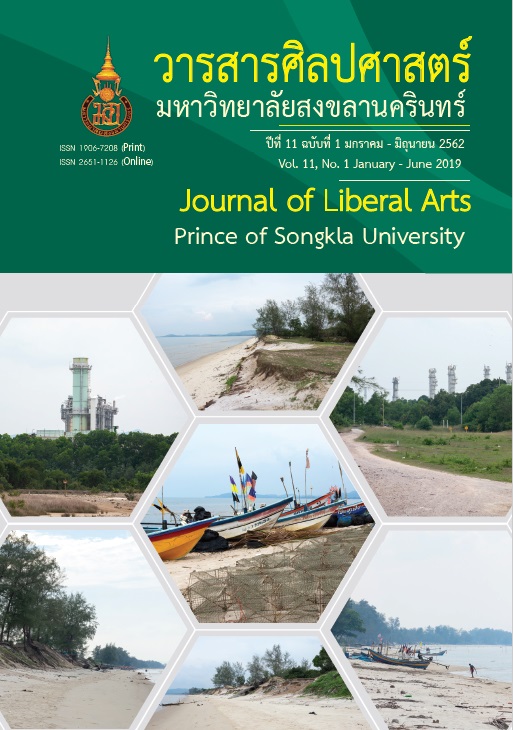ผลการคัดกรองพฤติกรรมเสี่ยงต่อการรังแกผู้อื่น ของนักเรียนโรงเรียนเอกชนสอนศาสนาอิสลามในจังหวัดยะลา
บทคัดย่อ
การวิจัยครั้งนี้มีวัตถุประสงค์เพื่อศึกษาผลการคัดกรองพฤติกรรมเสี่ยงต่อการรังแกผู้อื่นของนักเรียนโรงเรียนเอกชนสอนศาสนาอิสลามในจังหวัดยะลาและวิเคราะห์ปัจจัยเสี่ยงของตัวแปรเพศและระดับชั้นที่สัมพันธ์กับพฤติกรรมเสี่ยงต่อการรังแกผู้อื่น โดยเก็บข้อมูลจากกลุ่มตัวอย่างจำนวน 1,500 คนด้วยแบบคัดกรองที่ผู้วิจัยพัฒนาขึ้นมา และวิเคราะห์ข้อมูลโดยใช้คอมพิวเตอร์โปรแกรมอาร์ เพื่อวิเคราะห์หาค่าความถี่ ค่าร้อยละ ค่าเฉลี่ย ค่าส่วนเบี่ยงเบนมาตรฐาน ค่าการทดสอบไคสแควร์ และค่าสัมประสิทธิ์สหสัมพันธ์โลจีสติก
ผลการวิจัยพบว่า นักเรียนโรงเรียนเอกชนสอนศาสนาอิสลามในจังหวัดยะลาจำนวนร้อยละ 32.53 ที่แบบคัดกรองทั้ง 2 ชุดจำแนกอยู่ในกลุ่มที่มีพฤติกรรมเสี่ยงต่อการรังแกผู้อื่น โดยนักเรียนมีพฤติกรรมการรังแกผู้อื่นจากการตอบแบบคัดกรองชุดที่ 1 และแบบคัดกรองชุดที่ 2 โดยรวมอยู่ในระดับปานกลาง ( = 1.60 และ 1.59 ตามลำดับ) และตัวแปรเพศและระดับชั้นของนักเรียนเป็นปัจจัยเสี่ยงที่สัมพันธ์กับพฤติกรรมเสี่ยงต่อการรังแกผู้อื่นอย่างมีนัยสำคัญที่ระดับ 0.001 โดยนักเรียนที่มีโอกาสสูงที่จะมีพฤติกรรมเสี่ยงต่อการรังแกผู้อื่นได้แก่ นักเรียนเพศชาย (1.43 เท่า) และนักเรียนชั้นประถมศึกษาปีที่ 6 (4.78 เท่า) นักเรียนชั้นประถมศึกษาปีที่ 5 (3.88 เท่า) นักเรียนชั้นประถมศึกษาปีที่ 4 (2.57 เท่า) และนักเรียนชั้นประถมศึกษาปีที่ 3 (1.94 เท่า) ซึ่งผลการศึกษานี้เป็นประโยชน์ต่อบุคคลและหน่วยงานที่เกี่ยวข้องสำหรับกำหนดนโยบายการป้องกันและแก้ไขปัญหาพฤติกรรมการรังแกของนักเรียนได้อย่างทันท่วงที ก่อนที่ปัญหาดังกล่าวจะทวีความรุนแรงมากขึ้นจนกลายเป็นปัญหาสังคมที่ยากต่อการแก้ไขในอนาคต
References
Ahmed, E., & Braithwaite, V. (2004). Bullying and victimization: Cause for concern for both families and schools. Social Psychology of Education, 7, 35–54.
Atlas, R. S., & Pepler, D. J. (1998). Observations of bullying in the classroom. Journal of Educational Research, 92, 86–100.
Bernstein, J. Y., & Watson, M. W. (1997). Children who are targets of bullying. Journal of Interpersonal Violence, 12, 483–499.
Besag, V. E. (1989). Bullies and victims in schools. Milton Keynes: Open University Press.
Besag, V. E. (2006). Bullying among girls: Friends or foes? School Psychology International, 27(5), 535–551.
Boulton, M., & Underwood, K. (1992). Bully/victim problems among middle school children. The British journal of educational psychology, 62, 73–87.
Coloroso, B. (2004). The bully, the bullied, and the bystander: From pre-school to high school: How parents and teachers can help break the cycle of violence. New York: Harper Collins.
Craig, W. (1998). The relationship among bullying, victimization, depression, anxiety, and aggression in elementary school children. Personality and individual differences, 24(1), 123–130.
Department of Mental Health. (2001). The screening inventory of mental health. Bangkok: Ministry of Public Health.
Egbochuku, E. O. (2007). Bullying in Nigerian schools: Prevalence study and implications for counseling, Journal of Social Science, 14(1): 65–71.
Farrington, D. (1993). Understanding and preventing bullying. In Tonry, M. & Morris, N. (Eds.). Crime and justice: A review of the research (pp. 381–458). Chicago: University of Chicago Press.
Gini, G. (2008). Associations between bullying behavior, psychosomatic complaints, emotional and behavioral problems. Journal of Pediatric and Child Health, 44, 492–497.
Greeff, P. (2004). The nature and prevalence of bullying during the intermediate school phase (Unpublished master’s thesis). University of the Free State, Bloemfontein.
Hanish, L. D. (2000). Children who get victimized at school: What is known? What can be done? Professional School Counseling, 4, 113–120.
Hawkins, D. L., Pepler D. J., & Craig, W. M. (2001). Naturalistic observations of peer interventions in bullying. Social Development, 10(4), 512–527.
Hazler, R. J. (2000). When victims turn aggressors: Factors in the development of deadly school violence. Professional School Counseling, 4, 105–114.
Information Technology Operations Center. (2015). Criteria for school size. Bangkok: Office of the Basic Education Commission. [in Thai]
Junger–Tas, J. (1996). Youth and violence in Europe. Studies on Crime and Crime Prevention, 5(1), 31–58.
Junlapiya, P. (2007). Relationships between the perception of bullying behavior and bullying behavior of students in Chiang Mai Province (Unpublished master’s thesis). Mahidol University, Bangkok. [in Thai]
Kaltiala-Heino, R., & Rimpela, M. (1999). Bullying, depression, and suicidal ideation in Finnish adolescents: School survey. BMJ: British Medical Journal, 319, 348–356.
Laeheem, K. (2009). Bullying Behavior in Pattani Primary Schools (Unpublished Doctoral Dissertation). Prince of Songkla University, Pattani. [in Thai]
Laeheem, K. (2013a). Bullying behavior among primary school students in Islamic private schools in Pattani Province. Kasetsart Journal: Social Sciences, 34(3), 500–513.
Laeheem, K. (2013b). Family and upbringing background of students with bullying behavior in Islamic private schools, Pattani Province, Southern Thailand. Asian Social Sciences, 9(7), 162–172. [in Thai]
Laeheem, K., Kuning, M., & McNeil, N. (2009). Bullying: Risk factors becoming ‘Bullies’. Asian Social Science, 5(5), 50–57.
Laeheem, K., Kuning, M., McNeil, N., & Besag, V. E. (2008). Bullying in Pattani primary schools in Southern Thailand. Child: Care Health and Development, 35(2), 178–183.
Laeheem, K. & Chongruksa, D. (2011). Factors predicting bullying behaviors of Prathomsueksa six students in Pattani municipal schools. Songklanakarin Journal of Social Sciences and Humanities, 17(4), 625–642. [in Thai]
Laeheem, K. (2013). Students bullying behaviors. Songkhla: Prince of Songkla University. [in Thai]
Laeheem, K. (2014). Factors related to students’ bullying behavior in Islamic private schools, Songkhla Province. Srinakharinwirot Research and Development. Journal of Humanities and Social Sciences, 6(12),14–30. [in Thai]
Laeheem, K. (2015). Application R program for quantitative data analysis. Songkhla: Prince of Songkla University. [in Thai]
Laeheem, K., & Baka, D. (2012). A study of Thai youth’s violent behavior in the three southern border provinces of Thailand. NIDA Development Journal, 52(1), 159–187. [in Thai]
Laeheem, K., & Sungkharat, U. (2012a). Relationships between affective characteristics factors, family upbringing factors, violence influence factors, and bullying behavior of Islamic private schools students’ in Songkhla Province. Journal of Liberal Arts, Prince of Songkla University, 4(2), 65–82. [in Thai]
Laeheem, K., & Sungkharat, U. (2012b). Development of screening inventory for students at risk of exposure to bullying behavior in Islamic private schools, Songkhla Province. Kasetsart Journal: Social Sciences, 33(2), 175–187. [in Thai]
Laeheem, K., & Sungkharat, U. (2014). Predicting factors for bullying behavior of Islamic private schools students’ in Songkhla Province. NIDA Development Journal, 54(1), 189–220. [in Thai]
Marano, H. E. (1995). Big bad bully. Psychology Today, 28(5), 51–82.
Ministry of Education. (2000). Islamic studies curriculum followed the basic education core curriculum B.E. 2551 (A.D. 2008). Bangkok: Office of the Basic Education Commission. [in Thai]
Pengpinij, T. (2006). Violence, then we will blame anyone. Banmuang, (January 25, 2006), 19. [in Thai]
Tapanya, S. (2006). The survey of students’ bullying problem. Chiang Mai: Chiang Mai University. [in Thai]
Veenstra, R., Lindenberg, S., Oldehinkel, A. J., De Winter, A. F., Verhulst, F. C., & Ormel, J. (2005). Bullying and victimization in elementary schools: A comparison of bullies, victims, bully/victims, and uninvolved preadolescents. Developmental Psychology, 41, 672–682.
Walsh, J. M. (2005). Teacher perception concerning bullying and victimization. Pittsburgh PA: the thesis of doctoral degree, Duquesne University.
Wan Salwina, W. I., Susan, M. K., Nik Ruzyanei, N. J., Tuti Iryani, M. D., Syamsul, S., Aniza, A., & Zasmani, S. (2009). School bullying amongst standard students attending primary national schools in the federal territory of Kuala Lumpur: The prevalence and associated socio demographic factors, Malaysian Journal of Psychiatry, 18(1), 5–12.
Yodprang, B. (2007). Bullying among lower secondary school students in Pattani province (Unpublished master’s thesis). Prince of Songkla University, Pattani. [in Thai]
Downloads
เผยแพร่แล้ว
How to Cite
ฉบับ
บท
License
ลิขสิทธิ์บทความเป็นของผู้เขียน แต่วารสารศิลปศาสตร์ มหาวิทยาลัยสงขลานครินทร์ ขอสงวนสิทธิ์ในการเป็นผู้ตีพิมพ์เผยแพร่เป็นครั้งแรก




